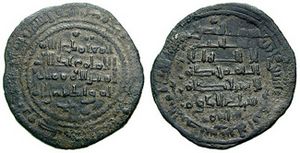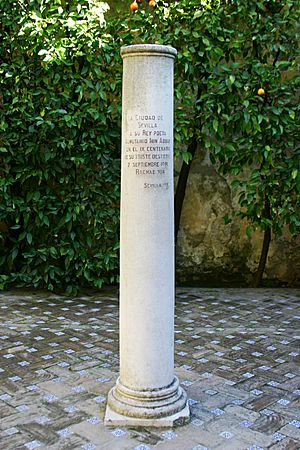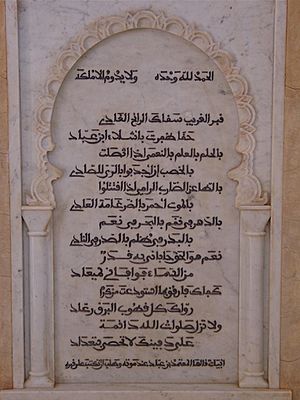Al-Mu'tamid ibn Abbad facts for kids
Quick facts for kids Al-Mu'tamid ibn Abbad |
|||||
|---|---|---|---|---|---|

Billon dirham coin of al-Mu'tamid ibn Abbad
|
|||||
| Emir of the Seville Taifa | |||||
| Reign | 1069–1091 | ||||
| Predecessor | Abbad II al-Mu'tadid | ||||
| Successor | Yusuf ibn Tashfin (as Almoravid ruler) | ||||
| Born | c. 1040 Beja, Al-Andalus |
||||
| Died | c. 1095 Aghmat, Almoravid Empire (now Morocco) |
||||
| Burial | Aghmat | ||||
| Children | Buthaina (daughter) Zaida (daughter) | ||||
|
|||||
| Dynasty | Abbadid | ||||
| Father | Abbad II al-Mu'tadid | ||||
| Religion | Sunni Islam | ||||

Al-Mu'tamid Muhammad ibn Abbad al-Lakhmi (Arabic: المعتمد محمد ابن عباد بن اسماعيل اللخمي; reigned about 1069–1091, lived 1040–1095), also known as Abbad III, was an important ruler and a famous poet. He was the third and last ruler of the Taifa of Seville in Al-Andalus, which was a Muslim kingdom in what is now Spain and Portugal. He was the last ruler from the Abbadid dynasty of Seville. His rule ended when the Almoravids took over in 1091.
Contents
Early Life and His Advisor
When Al-Mu'tamid was around 13 years old, his father gave him the title of Emir, which is like a prince or governor. His father also appointed a well-known poet named Ibn Ammar to be his main advisor, called a vizier. Al-Mu'tamid became very close to Ibn Ammar.
However, Al-Mu'tamid's father worried about how much influence Ibn Ammar had over his son. Because of this, he eventually sent Ibn Ammar away from the court.
Becoming a Ruler
After his father, Abbad II al-Mu'tadid, died in 1069, Al-Mu'tamid became the ruler of Seville. One of the first things he did was to bring Ibn Ammar back. He gave Ibn Ammar important military roles and high political jobs, including being the Governor of Silves and the Prime Minister in Seville.
Later, their friendship and working relationship became difficult. One reason for this was that Ibn Ammar allowed Al-Mu'tamid's son, Prince al-Rasid, to be captured during a military campaign. Ibn Ammar also declared himself the ruler of Murcia without properly recognizing Al-Mu'tamid's authority. The two men started to criticize each other in their poems. Murcia was eventually lost, and Ibn Ammar himself was captured. When Ibn Ammar tried to plot with the young prince against Al-Mu'tamid, it was too much. Al-Mu'tamid was very angry and ended their relationship. After Ibn Ammar's death, Al-Mu'tamid was said to have been very sad and gave his former friend a grand funeral.
Ruling the Kingdom
Al-Mu'tamid's kingdom was quite large. To the west, it included land between the Guadalquivir and Guadiana rivers, and areas around Niebla, Huelva, and Saltes. In the south, it stretched to Morón, Arcos, Ronda, and also Algeciras and Tarifa. He even took control of Córdoba, a major city, in 1070. He lost it in 1075 but got it back in 1078.
Despite his power, Al-Mu'tamid's family had to pay taxes to the King of Castile, who was a powerful Christian ruler. These taxes made his kingdom weaker. When Al-Mu'tamid decided to stop paying these taxes, King Alfonso VI of Castile attacked Seville. Alfonso VI had already conquered Toledo in 1085.
Asking for Help
To fight against the Castilian king, Al-Mu'tamid asked for help from the Berber Almoravids from Morocco. The Almoravid ruler, Yusuf ibn Tashfin, agreed to help. Al-Mu'tamid supported Yusuf ibn Tashfin against Alfonso VI in the Battle of Sagrajas in 1086.
The Moroccans set up their base in Algeciras. After they defeated the Christian forces, they started to take over all the Muslim kingdoms, called taifas, including Seville itself in 1091. When the Almoravids attacked Seville, Al-Mu'tamid told his sons to give up the royal fortress (the early Alcázar of Seville) to save their lives.
His son, Rashid, had advised him not to ask Yusuf ibn Tashfin for help. But Al-Mu'tamid famously replied:
I do not want my children to remember me as the person who let Al-Andalus be taken by non-believers. I do not want my name to be cursed in every Muslim prayer. For me, I would rather be a camel-driver in Africa than a pig herder in Castile.
Capture and Legacy
In 1091, Al-Mu'tamid was captured by the Almoravids. He was sent away to Aghmat, in Morocco, where he passed away around 1095. Some believe he might have been assassinated. His grave is located outside Aghmat.

Al-Mu'tamid is remembered as one of the most important people of the 11th century in Al-Andalus. He was highly respected as a poet who wrote in Arabic. He was also connected to Zaida of Seville, who became a companion of King Alfonso VI of Castile. Some historical records say Zaida was Al-Mu'tamid's daughter-in-law, married to his son Abu Nasr al-Fath al-Ma'mūn, who was the Emir of Córdoba. Other Christian records from that time said she was his daughter. Today, most historians agree that the Muslim records are more accurate, and Zaida was likely his daughter-in-law.
See also
 In Spanish: Muhámmad al-Mutámid para niños
In Spanish: Muhámmad al-Mutámid para niños
- Abbadid dynasty
- Buthaina bint al-Mu'tamid ibn Abbad

